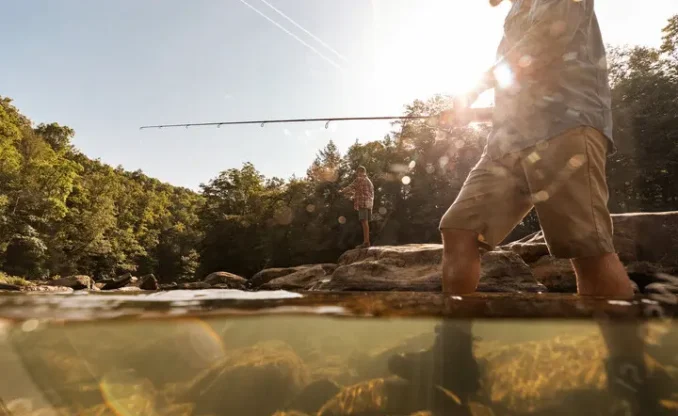Family: Centrarchidae
Common Family: The Sunfish Family
Common Name: Bluegill
Scientific Name: Lepomis macrochirus
Ecological Description/Identification
Bluegill are generally silver to greenish with a breast and belly area that can be yellow to a deep orange or rusty color. Large males especially may develop blue coloration near the gills and a red-orange breast area. Bluegills have long pointed pectoral fins that go past the eye when folded forwards. They also have a small mouth that does not extend beyond the eye. Adult bluegill will have a black blotch near the end of the soft dorsal fin.
Habitat
Bluegill are very common in West Virginia’s warm-water streams, lakes, ponds and reservoirs. They like weedy areas or woody cover along the shoreline where they can hide and obtain food. Insects, zooplankton and other small invertebrates are their primary food source. During summertime, bluegill set up clusters of community nests in shallow water that are often visible from the shoreline. Large male bluegill make these nests by “sweeping” the bottom with their fins to expose sand or gravel and creating circular depressions up to two feet wide.
Conservation Issues
Bluegill tolerate a wide range of environmental conditions, and populations are often resilient to various conservation threats. Loss of suitable spawning habitat such as shallow water, with vegetation and sand/gravel bottom can lead to reduced populations. Also, anglers can sometimes reduce the availability of large bluegills by selectively overharvesting the largest male fish, leaving only smaller fish in the population.
Facts
Bluegill are very easy to catch and are a great starting species for children and beginners. If you just want to get out of the house and catch something, bluegill are the fish for you. However, large bluegills can be more challenging and are often targeted by experienced and dedicated anglers. Bluegill are also regarded as good table fare with mild tasting meat. Small lures, wet flies and small live bait such as mealworms and earthworms fished near the shore and nests produce nice catches of bluegill in West Virginia. Most bluegill caught will be 3 to 8 inches, but some fish may get over 10 inches. The West Virginia length record for Bluegill is 13. 75 inches (Dennis Criss, 1964). and the weight record is 2.75 pounds (Mark Allen Lewis, 1986.)
Similar Species
Longear and green sunfish have short rounded pectoral fins and larger mouths.



